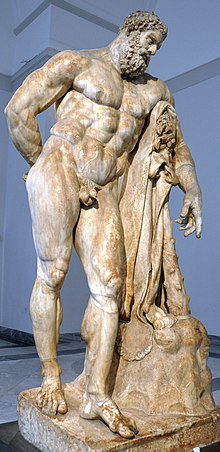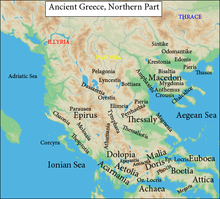|
Greek coin of the Akarnanian League in Akarnania
Bronze 20mm (5.54 grams) Struck circa 250-167 B.C.
Reference: HGC 4, 738; Sear 2314
Head of Athena left, in crested Attic helmet.
Bearded head of river-god Achelous left; trident right above.
The rugged region in north-western Greece, according to Greek mythology derived it’s name from Akarnan, son of the Argive king Amphiarios who settled at the mouth of the Achelous river. The myth goes that the river-god Archelous and Hercules had a competition for the hand in marriage of Deianaira, an Aitolian princess. When wrestling Hercules, Archelous transformed first into a serpent and then into a man-headed bull, with the ultimate victory going to Hercules. While wrestling, Hercules tore one of the the horns of Archelous off. The power the river-god had was to water the land fruitful, and in correlation his horn became the cornucopia (“full horn” or “horn of plenty”) with the amazing power to always refill itself.
You are bidding on the exact item pictured, provided with a Certificate of Authenticity and Lifetime Guarantee of Authenticity.
In Greek mythology, Achelous was the patron deity of the “silver-swirling” Achelous River, which is the largest river of Greece, and thus the chief of all river deities, every river having its own river spirit. His name is pre-Greek, its meaning unknown. The Greeks invented etymologies to associate it with Greek word roots (one such popular etymology translates the name as “he who washes away care”). However, these are etymologically unsound and of much later origin than the name itself.

Achelous was often reduced to a bearded mask, an inspiration for the medieval Green Mann. Floor mosaic, Zeugma, Turkey.
  Heracles, born Alcaeus (Alkaios) or Alcides, was a divine hero in Greek mythology, the son of Zeus and Alcmene, foster son of Amphitryon and great-grandson and half-brother (as they are both sired by the god Zeus) of Perseus. He was the greatest of the Greek heroes, a paragon of masculinity, the ancestor of royal clans who claimed to be Heracleidae and a champion of the Olympian order against chthonic monsters. In Rome and the modern West, he is known as Hercules, with whom the later Roman emperors, in particular Commodus and Maximian, often identified themselves. The Romans adopted the Greek version of his life and works essentially unchanged, but added anecdotal detail of their own, some of it linking the hero with the geography of the Central Mediterranean. Details of his cult were adapted to Rome as well. Heracles, born Alcaeus (Alkaios) or Alcides, was a divine hero in Greek mythology, the son of Zeus and Alcmene, foster son of Amphitryon and great-grandson and half-brother (as they are both sired by the god Zeus) of Perseus. He was the greatest of the Greek heroes, a paragon of masculinity, the ancestor of royal clans who claimed to be Heracleidae and a champion of the Olympian order against chthonic monsters. In Rome and the modern West, he is known as Hercules, with whom the later Roman emperors, in particular Commodus and Maximian, often identified themselves. The Romans adopted the Greek version of his life and works essentially unchanged, but added anecdotal detail of their own, some of it linking the hero with the geography of the Central Mediterranean. Details of his cult were adapted to Rome as well.
Extraordinary strength, courage, ingenuity, and sexual prowess with both males and females were among the characteristics commonly attributed to him. Heracles used his wits on several occasions when his strength did not suffice, such as when laboring for the king Augeas of Elis, wrestling the giant Antaeus, or tricking Atlas into taking the sky back onto his shoulders. Together with Hermes he was the patron and protector of gymnasia and palaestrae. His iconographic attributes are the lion skin and the club. These qualities did not prevent him from being regarded as a playful figure who used games to relax from his labors and played a great deal with children. By conquering dangerous archaic forces he is said to have “made the world safe for mankind” and to be its benefactor. Heracles was an extremely passionate and emotional individual, capable of doing both great deeds for his friends (such as wrestling with Thanatos on behalf of Prince Admetus, who had regaled Heracles with his hospitality, or restoring his friend Tyndareus to the throne of Sparta after he was overthrown) and being a terrible enemy who would wreak horrible vengeance on those who crossed him, as Augeas, Neleus and Laomedon all found out to their cost.
Acarnania is a region of west-central Greece that lies along the Ionian Sea, west of Aetolia, with the Achelous River for a boundary, and north of the gulf of Calydon, which is the entrance to the Gulf of Corinth. Today it forms the western part of the regional unit of Aetolia-Acarnania. The capital and principal city in ancient times was Stratos. The north side of Acarnania of the Corinthian Gulf was considered part of the region of Epirus.
Acarnania’s foundation in Greek mythology was traditionally ascribed to Acarnan, son of Alcmaeon.

Ancient Greek Northern regions
History
Classical

Map of ancient Acarnania.
In the 7th century BC,[2] Greek influence in the region becomes prominent when Corinth settled Anactorium, Sollium and Leucas, and Kefalonia settled Astacus. Settlements in Alyzeia, Coronta, Limnaea, Medion, Oeniadae, Palaerus, Phytia and Stratus are also mentioned by Thucydides, this latter city being the seat of a loose confederation of Acarnanian powers that was maintained until the late 1st century BC.
Because it is located strategically on the maritime route to Italy, Acarnania was emmired in many wars. In 5th century BC, the Corinthians were forced out of their Acarnanian settlements by Athens. In 4th century BC, c. 390 BC, the cities of Acarnania surrendered to the Spartans under King Agesilaus, and continued to be Spartan allies until joining the Second Athenian Empire in 375 BC. The Acarnanians later sided with Boeotia in their fight against Sparta, and with Athens against Philip II of Macedon at Chaeronea.
Acarnania thereafter came under Macedonian rule. In 314 BC, at the behest of Macedonian king Cassander, the settlements of Acarnania lying near the Aetolian border were conglomerated into fewer, larger settlements. Still, border conflicts with the Aetolians were frequent, and led to Acarnania’s territory being partitioned between Aetolia and Epirus, c. 250 BC. After the fall of the king of Epirus, the Acarnanian territory that had been given to Epirus regained its independence, and gained Leucas from Epirus, which became the capital of the region.
Acarnania allied itself with Philip V of Macedon against Rome in 200 BC, although it lost Leucas because of this, and the city of Thyrreion was anointed the new capital.
In the 1st century BC, Acarnania suffered greatly at the hands of pirates, and in Rome’s civil wars. Afterwards, the towns and settlements of Acarnania fell under the rule of Nicopolis.
Byzantine
Main article: Nicopolis (theme)
When the Byzantine Empire broke up (1204), Acarnania passed to the Despotate of Epirus and in 1348 it was conquered by Serbia. Then in 1480 it fell to the Ottoman Empire. Since 1832 it has been part of Greece.
Modern
Main article: Aetolia-Acarnania
Geography
Acarnania is composed of three main regions: 1) a rocky coastline, 2) a rugged strip of mountain range that follows the coastline, and 3) plains lying between these mountains and the Achelous River.
|







 Heracles, born Alcaeus (Alkaios) or Alcides, was a divine hero in Greek mythology, the son of Zeus and Alcmene, foster son of Amphitryon and great-grandson and half-brother (as they are both sired by the god Zeus) of Perseus. He was the greatest of the Greek heroes, a paragon of masculinity, the ancestor of royal clans who claimed to be Heracleidae and a champion of the Olympian order against chthonic monsters. In Rome and the modern West, he is known as Hercules, with whom the later Roman emperors, in particular Commodus and Maximian, often identified themselves. The Romans adopted the Greek version of his life and works essentially unchanged, but added anecdotal detail of their own, some of it linking the hero with the geography of the Central Mediterranean. Details of his cult were adapted to Rome as well.
Heracles, born Alcaeus (Alkaios) or Alcides, was a divine hero in Greek mythology, the son of Zeus and Alcmene, foster son of Amphitryon and great-grandson and half-brother (as they are both sired by the god Zeus) of Perseus. He was the greatest of the Greek heroes, a paragon of masculinity, the ancestor of royal clans who claimed to be Heracleidae and a champion of the Olympian order against chthonic monsters. In Rome and the modern West, he is known as Hercules, with whom the later Roman emperors, in particular Commodus and Maximian, often identified themselves. The Romans adopted the Greek version of his life and works essentially unchanged, but added anecdotal detail of their own, some of it linking the hero with the geography of the Central Mediterranean. Details of his cult were adapted to Rome as well.






